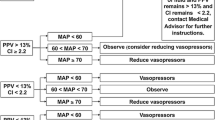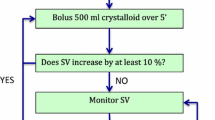Abstract
Purpose
Intraoperative fluid infusion strategy remains controversial. Many animal model studies have shown that restricted fluid infusion reduces blood loss, though reports on this topic in humans are rare. The purpose of this study was to determine the effects on volume of blood loss of a restricted fluid infusion strategy for hepatectomy in donors for livingdonor liver transplantation.
Methods
A before-after study design was used with prospective consecutive data collection. A total of 22 patients who underwent living-donor hepatectomy were enrolled. Eleven patients who were managed before the implementation of restricted-volume fluid administration comprised the standard-volume group, and 11 who were evaluated after the implementation of the restricted-volume infusion strategy comprised the restricted-volume group. In the standard-volume group, the donors were given 10 ml·kg−1·h−1 of lactated Ringer’s solution and additional plasma expander corresponding to blood loss. In the restricted-volume group, the donors received 5 ml·kg−1·h−1 of lactated Ringer’s solution until the resection of the hepatic graft, followed by 15 ml·kg−1·h−1 of lactated Ringer’s solution after the completion of resection until the end of the operation.
Results
Intraoperative blood loss was less in the restricted-volume group (445 ± 193 ml) than in the standard-volume group (1331 ± 602 ml; P < 0.01). Intraoperative fluid infusion was also less in the restricted-volume group (4130 ± 563 ml) than in the standard-volume group (5634 ± 1260 ml; P < 0.01). There were no differences in length of hospital stay or side effects between the two groups.
Conclusion
Our restricted-volume strategy reduced blood loss and had no adverse effects during living-donor hepatectomy.
Similar content being viewed by others
References
Burris D, Rhee P, Kaufmann C, Pikoulis E, Austin B, Eror A, DeBraux S, Guzzi L, Leppaniemi A. Controlled resuscitation for uncontrolled hemorrhagic shock. J Trauma. 1999;46:216–223.
Greene SP, Soucy DM, Song WC, Barber AE, Hagedorn FN, Illner HP, Shires GT. Early isotonic saline resuscitation from uncontrolled hemorrhage in rats. Surgery. 1998;124:568–574.
Bickell WH, Bruttig SP, Millnamow GA, O’Benar J, Wade CE. Use of hypertonic saline/dextran versus lactated Ringer’s solution as a resuscitation fluid after uncontrolled aortic hemorrhage in anesthetized swine. Ann Emerg Med. 1992;21:1077–1085.
Krausz MM, Bar-Ziv M, Rabinovici R, Gross D. “Scoop and run” or stabilize hemorrhagic shock with normal saline or small-volume hypertonic saline? J Trauma. 1992;33:6–10.
Solomonov E, Hirsh M, Yahiya A, Krausz MM. The effect of vigorous fluid resuscitation in uncontrolled hemorrhagic shock after massive splenic injury. Crit Care Med. 2000;28:749–754.
Kwan I, Bunn F, Roberts I. Timing and volume of fluid administration for patients with bleeding. Cochrane Database Syst Rev. 2003;CD002245.
Fujita S, Kim ID, Uryuhara K, Asonuma K, Egawa H, Kiuchi T, Hayashi M, Uemeto S, Inomata Y, Tanaka K. Hepatic grafts from live donors: donor morbidity for 470 cases of live donation. Transpl Int. 2000;13:333–339.
Mapstone J, Roberts I, Evans P. Fluid resuscitation strategies: a systematic review of animal trials. J Trauma. 2003;55:571–589.
Roberts I, Evans P, Bunn F, Kwan I, Crowhurst E. Is the normalisation of blood pressure in bleeding trauma patients harmful? Lancet. 2001;357:385–387.
Bickell WH, Wall MJ Jr, Pepe PE, Martin RR, Ginger VF, Allen MK, Mattox KL. Immediate versus delayed fluid resuscitation for hypotensive patients with penetrating torso injuries. N Engl J Med. 1994;331:1105–1109.
Dutton RP, Mackenzie CF, Scalea TM. Hypotensive resuscitation during active hemorrhage: impact on in-hospital mortality. J Trauma. 2002;52:1141–1146.
Chibber A, Dziak J, Kolano J, Norton JR, Lustik S. Anesthesia care for adult live donor hepatectomy: our experiences with 100 cases. Liver Transpl. 2007;13:537–542.
Itamoto T, Katayama K, Nakahara H, Tashiro H, Asahara T. Autologous blood storage before hepatectomy for hepatocellular carcinoma with underlying liver disease. Br J Surg. 2003;90:23–28.
Jones RM, Moulton CE, Hardy KJ. Central venous pressure and its effect on blood loss during liver resection. Br J Surg. 1998;85:1058–1060.
Schroeder RA, Collins BH, Tuttle-Newhall E, Robertson K, Plotkin J, Johnson LB, Kuo PC. Intraoperative fluid management during orthotopic liver transplantation. J Cardiothorac Vasc Anesth. 2004;18:438–441.
Wakeno-Takahashi M, Nakao S, Ikeda S, Kaibori M, Yamamoto H, Yanagida H, Kamiyama Y, Shingu K. A case of suspected severe pulmonary embolism in a living-related liver transplantation donor. J Clin Anesth. 2005;17:218–220.
Treib J, Haass A, Pindur G. Coagulation disorders caused by hydroxyethyl starch. Thromb Haemost. 1997;78:974–983.
Kozek-Langenecker SA. Effects of hydroxyethyl starch solutions on hemostasis. Anesthesiology. 2005;103:654–660.
Jamnicki M, Bombeli T, Seifert B, Zollinger A, Camenzind V, Pasch T, Spahn DR. Low- and medium-molecular-weight hydroxyethyl starches: comparison of their effect on blood coagulation. Anesthesiology. 2000;93:1231–1237.
Strauss RG, Pennell BJ, Stump DC. A randomized, blinded trial comparing the hemostatic effects of pentastarch versus hetastarch. Transfusion. 2002;42:27–36.
Ariens RA, Coppola R, Potenza I, Mannucci PM. The increase with age of the components of the tissue factor coagulation pathway is gender-dependent. Blood Coagul Fibrinolysis. 1995;6:433–437.
Gebara OC, Mittleman MA, Sutherland P, Lipinska I, Matheney T, Xu P, Welty FK, Wilson PW, Levy D, Muller JE. Association between increased estrogen status and increased fi brinolytic potential in the Framingham Offspring Study. Circulation. 1995;91:1952–1958.
Baker L, Meldrum KK, Wang M, Sankula R, Vanam R, Raiesdana A, Tsai B, Hile K, Brown JW, Meldrum DR. The role of estrogen in cardiovascular disease. J Surg Res. 2003;115:325–344.
Author information
Authors and Affiliations
About this article
Cite this article
Fujita, Y., Takeuchi, A., Sugiura, T. et al. Before-after study of a restricted fluid infusion strategy for management of donor hepatectomy for living-donor liver transplantation. J Anesth 23, 67–74 (2009). https://doi.org/10.1007/s00540-008-0708-1
Received:
Accepted:
Published:
Issue Date:
DOI: https://doi.org/10.1007/s00540-008-0708-1




